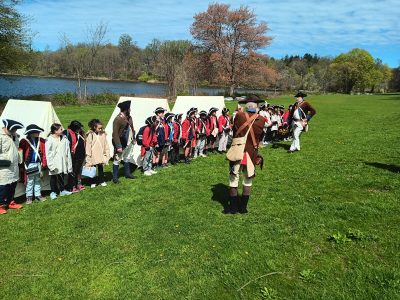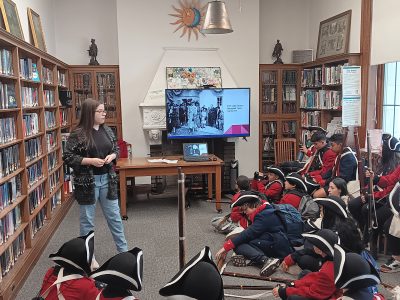Putnam Students Walk Through History That Hits Close to Home
News Based on facts, either observed and verified directly by the reporter, or reported and verified from knowledgeable sources.

Last Thursday morning, the sixth-graders at Carmel’s George Fischer Middle School were hard at work erecting their tents on the grassy area between Route 52 and Lake Gleneida, not far from the Sybil Luddington statue.
Wearing either red or blue coats, containers of water hanging from their clothing or slung around their shoulder and holding muskets, they were outfitted like the soldiers that served during the Revolutionary War who traversed some of the towns and villages throughout the Hudson Valley.
Their daylong excursion in and around Carmel was part of a historical walking tour organized by faculty at the school with a big assist from the Living History Education Foundation.
“If you get a handful of kids where it just spikes their interest, that’s when it’s worth it,” said George Fischer Middle School reading teacher Denise Santalis, who completed the Living History Education Foundation’s teacher program, which provided her students access to the Revolutionary War era clothing and equipment.
“You do it, you learn it and you remember it,” she added.
With the help of faculty at the middle school and history teachers at Carmel High School, the district developed a unit on local history in 2017, Santalis said. That includes heading out into the community to learn and experience where certain events took place as well as other milestones that happened over the generations.
Carmel Town Historian Alicia Briley, whose family dates back to before the Revolution in Putnam County, spoke to the students about the Reed Memorial Library at the intersection of routes 6 and 52, which has been at that location for 111 years; how Eleanor Roosevelt had family throughout the county (President Franklin D. Roosevelt was from Hyde Park, Dutchess County); and the Putnam County Courthouse, which was built in 1814 and is the second oldest courthouse in the state that is still in use.
However, some of the focus of the day was to experience a little of what soldiers in the Revolution encountered. Living History Education Foundation President Joseph Ryan, a retired Blue Mountain Middle School history teacher after a long career in the classroom and who devised the program, barked orders like a military commander at the students after as they set up their tents.
Ryan explained that some people may look at history as something that isn’t terribly exciting, but without the knowledge, communities are poorer from not knowing where they came from.

Over the past 20 years, 3,478 educators have completed the nonprofit organization’s courses in living history, he said. The foundation has collected about 40 tents and hundreds of Revolutionary and Civil War uniforms and muskets stored at several depots around the state, including the closest one in Croton-on-Hudson.
“Really, if we don’t study the history of our people, which is how we got here, the good, the bad and the ugly, you have no sense where you are and no sense of community, and I think that’s important,” Ryan said.
With the nation’s 250th anniversary approaching in a couple of years, this is the perfect time for schools and teachers to zero in on how the country formed and why it’s important, said Robert Buccheri, a Carmel High School history teacher and master educator for the foundation who was also dressed up in Revolutionary War garb with Ryan and the students.
That’s particularly important for schools in the Hudson Valley where there is ample history from that era, he said. Buccheri called it “a crime” if students didn’t understand their local history and what went on around them more than a couple of centuries ago.
“The idea is to get the kids understanding their local history, understanding what the soldiers did, how they lived,” Buccheri said. “It’s not something that we glorify; it’s something that these guys did, the soldiers that fought for the Revolution. It should be appreciated and it should be learned.”
Putnam County Historian Jennifer Cassidy said many of the important lessons of history can benefit the community centuries later.
“It’s so important for us to know everything that it took for us to get here as a county, as a country, even on a small scale here,” Cassidy said. “We were formed in 1812, having broken off from Dutchess County. To know these stories, these little nuggets is so important to share it with younger kids.”
To learn more about the Living History Education Foundation, visit www.livinghistoryed.org.

Martin has more than 30 years experience covering local news in Westchester and Putnam counties, including a frequent focus on zoning and planning issues. He has been editor-in-chief of The Examiner since its inception in 2007. Read more from Martin’s editor-author bio here. Read Martin’s archived work here: https://www.theexaminernews.com/author/martin-wilbur2007/
